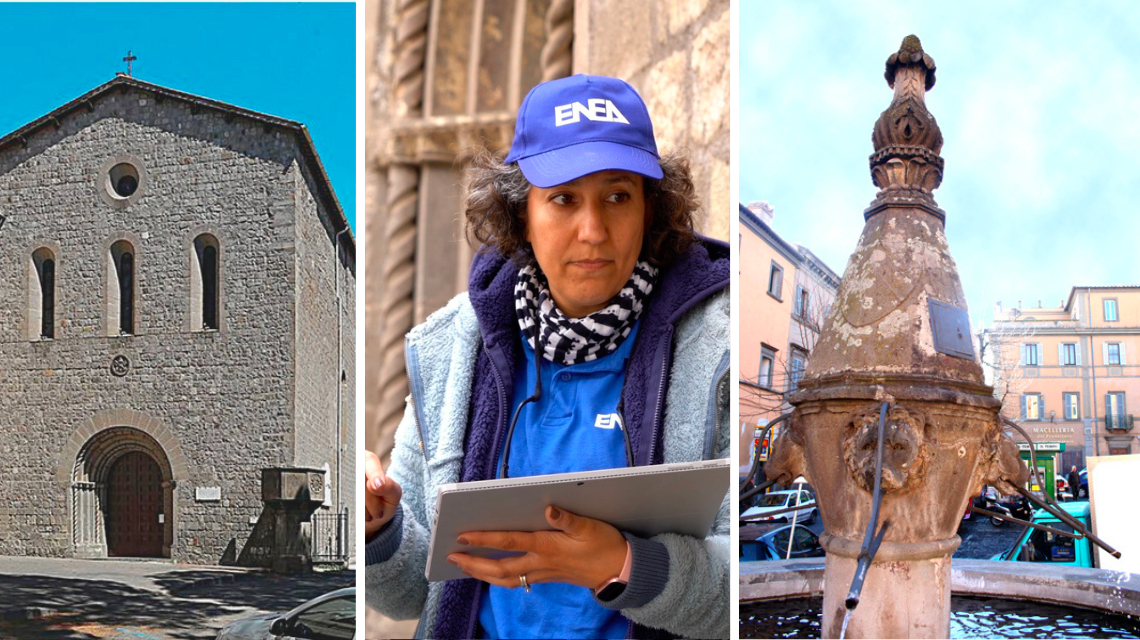Italian National Agency for New Technologies, Energy and Sustainable Economic Development

Cultural heritage: From ENEA a novel technique to restore damaged monuments
Restoring damaged peperino marble monuments with novel methods employing nanomaterials, advanced diagnostics and sensors, 3D models and drones to cut intervention times and costs was the focus of the project COLLINE, coordinated by ENEA, funded by the Lazio Region[1] and presented during the workshop "New Technologies for Cultural Heritage", which took place in the ENEA Frascati Research Center. The project, whose participants included the Universities of Tuscia and "Sapienza" of Rome and the two companies De Feo Restauri and Eagleprojects, focused on two artworks in peperino in Viterbo: the pulpit of the church of San Francesco alla Rocca and the fountain of San Faustino.
For a speedy intervention on these precious artefacts and long-lasting protection against external agents such as humidity and biological attacks, reasearchers used biocompatible and sustainable materials like essential oils and innovative nanomaterials, specifically developed in the ENEA Frascati Physical Technologies and Safety Division Labs.
“The surfaces of monuments and historic buildings exposed to atmospheric agents show different signs of deterioration, also depending on exposure times and orientation of surfaces”, explained Valeria Spizzichino of the Diagnostics and Metrology Laboratory.” Time, lack of conservation interventions, chemical and physical processes and biological attacks can cause aesthetic and structural damage to the stone materials in historical monuments, undermining their stability and affecting fruition of the artistic works", she said.
Using multispectral imaging techniques, Laser Induced Fluorescence (LIF), VIS-IR spectrophotometry and colorimetry, the research team conducted the optical and spectroscopic characterization to identify and map the original materials of the stone artefacts, the forms of degradation and traces of previous restorations.
The identification of the biodeteriogens present on the artefacts was performed on site using commercial and innovative lidar fluorosensor systems developed in the ENEA laboratories, which also confirmed the effectiveness of the treatments and the non-emergence of new forms of degradation.
The environmental and microclimatic conditions on the pulpit of San Francesco alla Rocca were evaluated and monitored through the use of FBG type (Bragg grating) fiber optic sensors, commercial temperature sensors and innovative humidity sensors developed at ENEA. This data, still being acquired, will enable us to differentiate the action of atmospheric agents on differently exposed surfaces and correlate it with the different types of biodegradation detected.
Finally, thanks to drones and 3D laser scanners, a detailed mapping of the artifacts under study and the related 3D models was created, later incorporated into a web-GIS platform which provides great visualization and measurement accuracy. Thanks to the information on the state of conservation of the artefacts, which can be updated based on the inputs transmitted by sensors and coming from diagnostic techniques, a georeferenced, queryable and monitorable map was created.
“This public-private partnership benefits all the actors involved, research institutions, companies and artworks managers who can enrich their knowledge and skills and lay the foundations for a further development, leading to improved and broader offers on the market", pointed out Rosaria D'Amato at the ENEA Laboratory of Micro and Nanostructures for Photonics. “In addition to technological transfer, this result shows benefits in terms of knowledge transfer from the Internet of Things to the Internet of Knowledge, stressing the central importance of knowledge in all its forms for creating value".
The innovative techniques that integrate computerization of interventions and investigation results significantly simplify maintenance processes and reduce costs. The creation of a web-GIS platform with the 3D models of the sites and the real-time data acquired by the sensors guarantees access, even in the future, to all the material collected and produced, providing a new modus operandi in the management and use of artistic objects, in line with the directives of the European Commission and the National Enterprise 4.0 Plan.
Photos and videos
Other archive videos, freely reproducible, are available on request.
